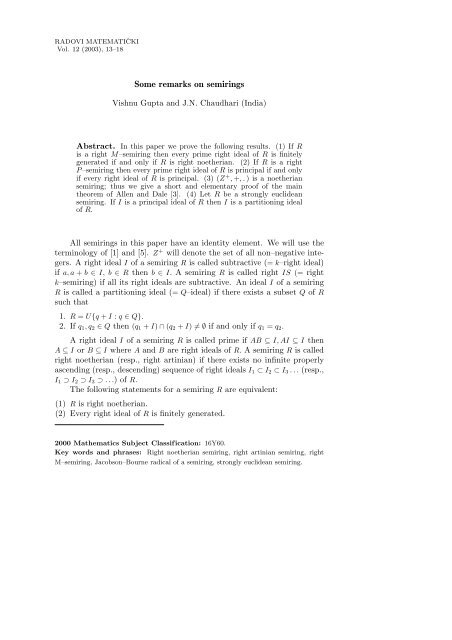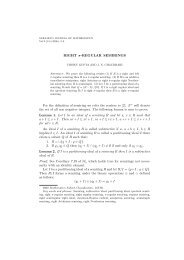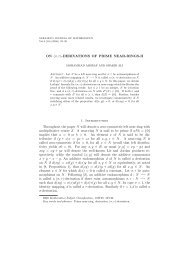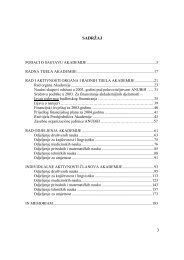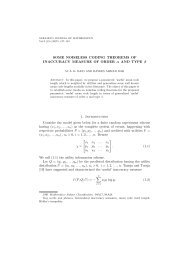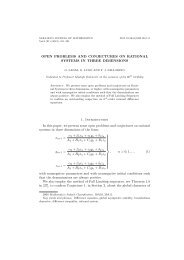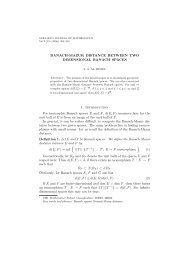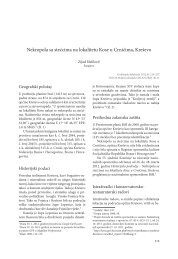Some remarks on semirings - anubih
Some remarks on semirings - anubih
Some remarks on semirings - anubih
You also want an ePaper? Increase the reach of your titles
YUMPU automatically turns print PDFs into web optimized ePapers that Google loves.
RADOVI MATEMATIČKIVol. 12 (2003), 13–18<str<strong>on</strong>g>Some</str<strong>on</strong>g> <str<strong>on</strong>g>remarks</str<strong>on</strong>g> <strong>on</strong> <strong>semirings</strong>Vishnu Gupta and J.N. Chaudhari (India)Abstract. In this paper we prove the following results. (1) If Ris a right M–semiring then every prime right ideal of R is finitelygenerated if and <strong>on</strong>ly if R is right noetherian. (2) If R is a rightP –semiring then every prime right ideal of R is principal if and <strong>on</strong>lyif every right ideal of R is principal. (3) (Z + , +, . ) is a noetheriansemiring; thus we give a short and elementary proof of the maintheorem of Allen and Dale [3]. (4) Let R be a str<strong>on</strong>gly euclideansemiring. If I is a principal ideal of R then I is a partiti<strong>on</strong>ing idealof R.All <strong>semirings</strong> in this paper have an identity element. We will use theterminology of [1] and [5]. Z + will denote the set of all n<strong>on</strong>–negative integers.A right ideal I of a semiring R is called subtractive (= k–right ideal)if a, a + b ∈ I, b ∈ R then b ∈ I. A semiring R is called right IS (= rightk–semiring) if all its right ideals are subtractive. An ideal I of a semiringR is called a partiti<strong>on</strong>ing ideal (= Q–ideal) if there exists a subset Q of Rsuch that1. R = U{q + I : q ∈ Q}.2. If q 1 , q 2 ∈ Q then (q 1 + I) ∩ (q 2 + I) ≠ ∅ if and <strong>on</strong>ly if q 1 = q 2 .A right ideal I of a semiring R is called prime if AB ⊆ I, AI ⊆ I thenA ⊆ I or B ⊆ I where A and B are right ideals of R. A semiring R is calledright noetherian (resp., right artinian) if there exists no infinite properlyascending (resp., descending) sequence of right ideals I 1 ⊂ I 2 ⊂ I 3 . . . (resp.,I 1 ⊃ I 2 ⊃ I 3 ⊃ . . .) of R.The following statements for a semiring R are equivalent:(1) R is right noetherian.(2) Every right ideal of R is finitely generated.2000 Mathematics Subject Classificati<strong>on</strong>: 16Y60.Key words and phrases: Right noetherian semiring, right artinian semiring, rightM–semiring, Jacobs<strong>on</strong>–Bourne radical of a semiring, str<strong>on</strong>gly euclidean semiring.
14Vishnu Gupta and J.N. Chaudhari(3) Any n<strong>on</strong>–empty collecti<strong>on</strong> of right ideals of R has a maximal element([5, Theorem 1.1]).A semiring R is called a right M–semiring if I is a right ideal of Rwhich is not finitely generated then there exists a subtractive right ideal Jof R such that I ⊆ J and J is maximal with respect to not being finitelygenerated (see [2]).Proporti<strong>on</strong> 1. A right IS–semiring is a right M–semiring.Proof. Let I be a right ideal of R which is not finitely generated.Let α be the class of all right ideals of R c<strong>on</strong>taining I and which are notfinitely generated. Clearly α is n<strong>on</strong>–empty. If α ′ is any totally orderedsubset of α then UJ J∈α ′ is a right ideal of R c<strong>on</strong>taining I that is not finitelygenerated. Hence UJ J∈α ′ ∈ α. By Zorn’s Lemma α has a maximal elementwhich by hypothesis is a subtractive right ideal of R. Therefore R is a rightM–semiring.Now we generalize the Theorem 11 of [2] for <strong>semirings</strong> that are notnecessarily be commutative.Theorem 2. If R is a right M–semiring then every prime right idealof R is finitely generated if and <strong>on</strong>ly if R is right noetherian.Proof. Let α = {I : I is a right ideal of R which is not finitelygenerated}. Suppose α ≠ ∅. Let I ∈ α. Since R is right M–semiring, thereexists a subtractive right ideal J in R such that I ⊆ J and J is maximalwith respect to not being finitely generated. If J is a prime right ideal thenby hypothesis J is finitely generated which is impossible. Hence J is not aprime right ideal. Thus there exist right ideals A, B in R such that AB ⊆ Jand AJ ⊆ J but A ⊈ J and B ⊈ J.Let a ∈ A such that a /∈ J. Then clearly J ⊂ J + aR. If J + aR isnot finitely generated then there exists a subtractive right ideal K in Rsuch that J + aR ⊆ K and K is maximal with respect to not being finitelygenerated since R is a right M–semiring. But then I ⊆ J ⊂ J + aR ⊆ K.Now by maximality of J, J = K = J + aR, a c<strong>on</strong>tradicti<strong>on</strong>. Hence J + aR isfinitely generated.Let J + aR = ∑ ni=1 a iR. Let (a : J) = {x ∈ R : ax ∈ J}. Then J + B ⊆(a : J), since AJ ⊆ J and AB ⊆ J. Moreover J ⊂ (a : J). It is easy toverify that (a : J) is a subtractive right ideal of R. Hence (a : J) is finitelygenerated.
<str<strong>on</strong>g>Some</str<strong>on</strong>g> <str<strong>on</strong>g>remarks</str<strong>on</strong>g> <strong>on</strong> <strong>semirings</strong> 15Let (a : J) = ∑ mi=1 b iR. Let a i = k i + ar i for some k i ∈ J and r i ∈ R.Clearly ∑ ni=1 k iR + a(a : J) ⊆ J. On the other hand, let u ∈ J. Thenu =n∑a i u i =i=1n∑(k i + ar i )u i =i=1n∑n∑k i u i + a r i u ifor some u 1 , u 2 , . . . , u n ∈ R. Since u, ∑ ni=1 k iu i ∈ J and J is a subtractiveright ideal, hence a ∑ ni=1 r iu i ∈ J. This implies that ∑ ni=1 r iu i ∈ (a : J). Sou ∈ ∑ ni=1 k iR + a(a : J). NowJ =n∑k i R + a(a : J) =i=1i=1(n∑m)∑k i R + a b i R =i=1i=1i=1i=1n∑ m∑k i R + ab i R.Hence J is finitely generated, a c<strong>on</strong>tradicti<strong>on</strong>. Hence α = ∅. Thus everyright ideal of R is finitely generated.A semiring R will be called a right P –semiring if for any right ideal Iof R which is not principal there exists a subtractive right ideal J of R suchthat I ⊆ J and J is maximal with respect to not being principal.Theorem 3. If R is a right P –semiring then every prime right idealof R is principal if and <strong>on</strong>ly if every right ideal of R is principal.Proof. Let α = {I : I is a right ideal of R which is not principal}. Supposeα ≠ ∅. Let I ∈ α. Since R is right P –semiring, there exists a subtractiveright ideal J of R such that I ⊆ J and J is maximal with respect to notbeing principal. It is clear that J is not a prime right ideal. Hence thereexist right ideals A and B of R such that AB ⊆ J and AJ ⊆ J but A ⊈ Jand B ⊈ J. Let a ∈ A be such that a ∉ J. Then clearly J ⊂ J + aR. Using thedefiniti<strong>on</strong> of right P –semiring, it can be shown that J + aR is a principalright ideal. Hence J + aR = bR for some b ∈ R.Let b = j 0 + ar 0 for some j 0 ∈ J and r 0 ∈ R. Let x ∈ J ⊆ bR. Thereforex = br for some r ∈ R. Now br = x ∈ J implies that r ∈ (b : J). Thereforex = br ∈ b(b : J). Hence J ⊆ b(b : J). Also b(b : J) ⊆ J. Now J = b(b : J).We claim that J = (b : J). It is clear that J ⊆ (b : J). If J ≠ (b : J) then(b : J) = dR for some d ∈ R, since (b : J) is a subtractive right ideal of R.Thus J = b(b : J) = bdR, which gives a c<strong>on</strong>tradicti<strong>on</strong>. Hence (b : J) = J.Since b = j 0 +ar 0 , it is easy to verify that J ⊆ (ar 0 : J). Since ar 0 B ⊆ AB ⊆ J,we have B ⊆ (ar 0 : J). Thus (ar 0 : J) ≠ J, for if (ar 0 : J) = J then B ⊆ J, ac<strong>on</strong>tradicti<strong>on</strong>.Let x ∈ (b : J). Then j 0 x + ar 0 x = (j 0 + ar 0 )x = bx ∈ J. Hence ar 0 x ∈ J,since j 0 x ∈ J and J is a subtractive right ideal. So x ∈ (ar 0 : J). Thus(b : J) ⊆ (ar 0 : J).i=1
<str<strong>on</strong>g>Some</str<strong>on</strong>g> <str<strong>on</strong>g>remarks</str<strong>on</strong>g> <strong>on</strong> <strong>semirings</strong> 17Let I (1) ⊇ I (2) ⊇ I (3) ⊇ . . . be a descending sequence of ideals of R. Fromthe above claim I (1) = I t = {0, 1, 2, . . . , t} for some t ∈ Z + or I (1) = Z + orI (1) = R. In any case there is no infinite properly descending sequence ofideals of R.Let I be an ideal of R and let a 1 , a 2 ∈ I. Then we can choose r 1 = r 2 =max{a 1 , a 2 } ∈ I such that a 1 + r 1 + a 1 r 1 + a 2 r 2 = a 2 + r 2 + a 1 r 2 + a 2 r 1 . Henceevery ideal of R is semiregular. Thus the Jacobs<strong>on</strong>–Bourne radical of R isR.The semiring R is not noetherian since I 0 ⊂ I 1 ⊂ I 2 ⊂ . . . is an infiniteproperly ascending sequence of ideals of R where I t = {0, 1, 2, . . . , t} fort ∈ Z + .A commutative semiring R will be called str<strong>on</strong>gly euclidean if thereexists a functi<strong>on</strong> d : R − {0} → Z + such that(1) d(ab) ≥ d(a) for all a, b ∈ R − {0} and(2) if a, b ∈ R with b ≠ 0then there exist unique elements q, r ∈ R such that a = bq + r where eitherr = 0 or d(r) < d(b).Theorem 6. Let R be a str<strong>on</strong>gly euclidean semiring. If I is a principalideal of R then I is a partiti<strong>on</strong>ing ideal of R.Proof. Let I =< a > . If a = 0 then I is a partiti<strong>on</strong>ing ideal of R whereQ = R. Suppose a ≠ 0. Let Q = {q ∈ R : d(q) < d(a)} ∪ {0}. Let b ∈ R. Thenthere exist unique elements p, q ∈ R such that b = ap + q where q = 0 ord(q) < d(a). Clearly b ∈ ∪{q + I : q ∈ Q}. Hence R = ∪{q + I : q ∈ Q}.For q 1 , q 2 ∈ Q, suppose that (q 1 +I)∩(q 2 +I) ≠ ∅. Let x ∈ (q 1 +I)∩(q 2 +I).Then q 1 + ax 1 = x = q 2 + ax 2 for some x 1 , x 2 ∈ R. But this representati<strong>on</strong> isunique. Hence q 1 = q 2 . Therefore I is a partiti<strong>on</strong>ing ideal of R.Acknowledgement. The authors express their sincere thanks to thereferee for his helpful suggesti<strong>on</strong>s.REFERENCES[1] P.J. Allen, A fundamental theorem of homomorphisms for <strong>semirings</strong>, Proc.Amer. Math. Soc, 21 (1969), 412–416.[2] P.J. Allen, Cohen’s theorem for the class of noetherian <strong>semirings</strong>, Publ.Math. Debrecen, 17 (1970), 169–171.[3] P.J. Allen and L. Dale, Ideal theory in Z + , Publ. Math. Debrecen, 22 (1975),219–224.[4] S. Bourne, The Jacobs<strong>on</strong> radical of a semiring, Proc. Nat. Acad. Sci, 37(1951), 163–170.
18Vishnu Gupta and J.N. Chaudhari[5] J.N. Chaudhari and V. Gupta, Weak primary decompositi<strong>on</strong> theorem forright noetherian <strong>semirings</strong>, Indian J. Pure and Appl. Math, 25 (1994), 647–654.[6] J.S. Golan, The Theory of Semirings with Applicati<strong>on</strong>s in Mathematics andTheoretical Computer Science, John Wiley and S<strong>on</strong>s, New York, 1992.[7] K. Iizuka, On the Jacobs<strong>on</strong> radical of a semiring, Tohoku Math. J, 11 (1959),409–421.[8] K. Koh, On prime <strong>on</strong>e sided ideals, Can. Math. Bull, 14 (1971), 259–260.[9] M.K. Sen and M.R. Adhikari, On maximal k–ideals of <strong>semirings</strong>, Proc.Amer. Math. Soc, 118 (1993), 699–703.(Received: June 26, 2003)(Revised: July 20, 2003)Vishnu GuptaDepartment of MathematicsUniversity of DelhiDelhi–110007Indiae–mail: vishnu gupta2k3@yahoo.co.inJ.N. ChaudhariDepartment of MathematicsM.J. CollegeJalga<strong>on</strong>–425002IndiaNeke napomene o poluprstenovimaVishnu Gupta i J.N. ChaudhariSadržajU radu se dokazuju slijedeći rezultati: (1) Ako je R desni M–poluprstentada je svaki prosti ideal od R k<strong>on</strong>ačno generiran ako i samo ako je R desnineterian. (2) Ako je R desni P –poluprsten tada je svaki prosti desni idealod R glavni ako i samo ako je svaki desni ideal od R glavni. (3) (Z + , +, . ) jeneterian poluprsten; prema tome se daje kratak i elementarni dokaz glavnogteorema Allen and Dale [3]. (4) Neka je R jaki euklidski poluprsten. Akoje I glavni ideal od R tada je I djelomični ideal od R.


